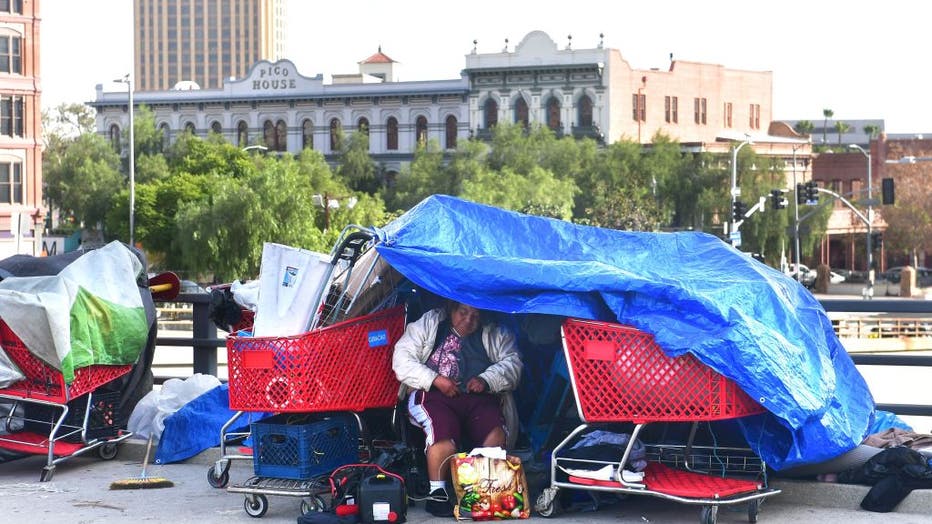Newsom pledges 1,200 tiny homes for California’s homeless

California to add 1,200 tiny homes to help homeless
Gov. Gavin Newsom said California will build 1,200 small homes across the state as part of an effort to help house the nation?s largest homeless population and to address an issue that has persistently plagued the state during his time in office.
LOS ANGELES - Gov. Gavin Newsom said Thursday that California will build 1,200 small homes across the state as part of an effort to help house the nation’s largest homeless population and to address an issue that has persistently plagued the state during his time in office.
Newsom announced the plans in Sacramento on the first stop of a planned four-city tour, during which major policy announcements are expected on housing, health care and public safety. The tour is replacing the governor’s traditional State of the State address.
With prototypes of the homes on display behind him during a speech at the state fairgrounds, Newsom said he hoped to have all of them constructed by the fall. They will be spread across four cities — Sacramento, San Jose, San Diego and Los Angeles — with local governments deciding exactly where to place them and being responsible for managing them.
The goal, he said, is to provide more options for homeless people who are "living out in the streets and sidewalks in these extraordinary and horrid conditions."
There were more than 170,000 people on California’s streets in 2022, according to federal data. Newsom said the 1,200 new homes are just one part of wide-ranging state efforts to tackle the issue. He’s approved more than $22.3 billion in spending on new housing and homelessness since taking office, according to the Legislative Analyst’s Office.
"I get it, you want to see progress and you want to see it now," Newsom said.
Republican state Senate Leader Brian Jones criticized the proposal, saying it’s another example of Newsom "throwing money" at the problem without solutions.
RELATED: Needle, Narcan handouts in Santa Monica parks spark outcry
"While I appreciate the governor’s creativity to construct 1,200 tiny homes, that is a drop in the bucket," he said in a statement.
Newsom dedicated his 2020 State of the State speech to homelessness, calling it a " disgrace " in a land of so much wealth. California, home to nearly 40 million people, has nearly one-third of the nation’s homeless population, and their numbers are growing much faster than in other states, according to an analysis of federal data by the Public Policy Institute of California.
His goal is to have the new homes placed on public land to house people living in encampments along roads and rivers. Sacramento will get 350 homes, Los Angeles will get 500, San Jose will get 200 and San Diego will get 150.
The homes will cost an estimated $30 million, Newsom spokesman Anthony York said.
Newsom also announced that he’d released more money to local governments to tackle homelessness following their commitment to be more aggressive about reducing the number of people on the streets.
Last fall Newsom delayed $1 billion of funding for local government homelessness programs because he didn’t like how they planned to spend it. Cumulatively, the local governments’ plans aimed to reduce the homeless population by just 2%. Newsom later released the money after a meeting with local leaders.
On Thursday the governor said local leaders have revised their plans with a goal of a 15% reduction.

(Photo by FREDERIC J. BROWN/AFP via Getty Images)
California’s homelessness problem is in part a byproduct of its shortage of affordable housing, an issue that advocates say impacts many more people than simply those living on the streets.
Leaders of the state’s biggest cities and counties want Sacramento to define more clearly their role in addressing homelessness and how the state will measure the success of local programs that receive state funding.
Currently state homelessness funding has "all sorts of rules that have to be put in and half a dozen different state departments involved in order to find one program," said Graham Knauss, executive director of the California State Association of Counties. "That needs to change. That is not government at its best."
The association’s solution is to ask the state Legislature to pass laws clearly defining the responsibilities of local and state government, coupled with recurring state funding for local governments every year. Knauss said the association is talking with lawmakers and the governor’s office about passing legislation.
"We certainly should not expect that we’re going to get ongoing progress on homelessness while using one-time funding to do it," he said.
The stakes are high for people like Nathen Avelar, 18, who has struggled with unstable housing most of his life. Avelar grew up with his mother and twin brother in the Central Valley city of Merced, where he said there is plenty of new housing but all out of their reach.
For a few years, they lived in a home that was infested with mold, which aggravated his brother’s asthma and forced them to leave. They moved in with his grandmother; if not for her home, which they often shared with multiple other family members, Avelar said they likely would have been homeless.
"I remember a couple of times we drove around looking for houses, and we always saw these nice houses on the street and I knew we would never be able to afford them," he said. "That was really disheartening."
Avelar, who worked part-time for a voter engagement group that supported Newsom during an unsuccessful 2021 recall attempt, said he wants the governor’s administration to build more affordable housing.

